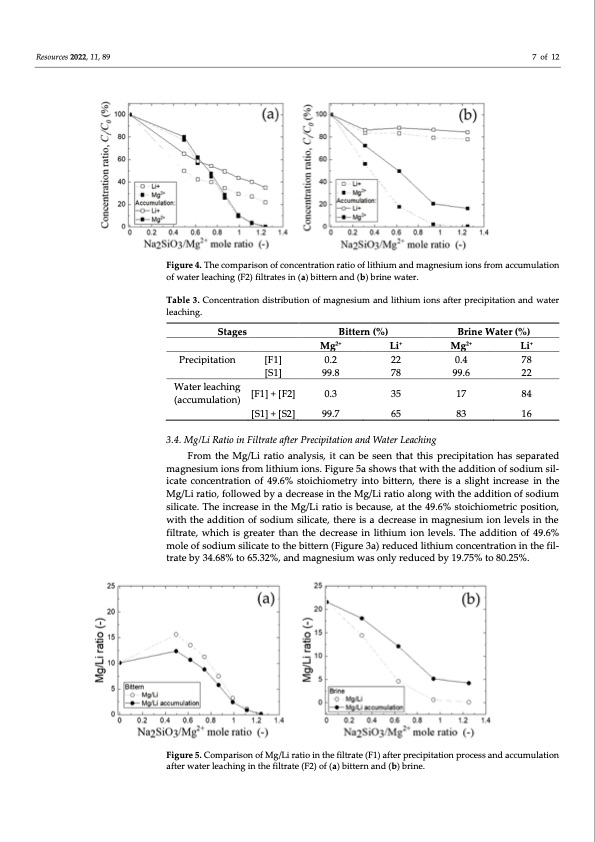
PDF Publication Title:
Text from PDF Page: 007
Resources 2022, 11, 89 7 of 12 Figure 4. The comparison of concentration ratio of lithium and magnesium ions from accumulation of water leaching (F2) filtrates in (a) bittern and (b) brine water. Table 3. Concentration distribution of magnesium and lithium ions after precipitation and water leaching. 3.4. Mg/Li Ratio in Filtrate after Precipitation and Water Leaching From the Mg/Li ratio analysis, it can be seen that this precipitation has separated magnesium ions from lithium ions. Figure 5a shows that with the addition of sodium sil- icate concentration of 49.6% stoichiometry into bittern, there is a slight increase in the Mg/Li ratio, followed by a decrease in the Mg/Li ratio along with the addition of sodium silicate. The increase in the Mg/Li ratio is because, at the 49.6% stoichiometric position, with the addition of sodium silicate, there is a decrease in magnesium ion levels in the filtrate, which is greater than the decrease in lithium ion levels. The addition of 49.6% mole of sodium silicate to the bittern (Figure 3a) reduced lithium concentration in the fil- trate by 34.68% to 65.32%, and magnesium was only reduced by 19.75% to 80.25%. Stages Bittern (%) Brine Water (%) Mg2+ Li+ Mg2+ Li+ Precipitation [F1] 0.2 22 0.4 78 [S1] 99.8 78 99.6 22 Water leaching (accumulation) [F1] + [F2] 0.3 35 17 84 [S1] + [S2] 99.7 65 83 16 Figure 5. Comparison of Mg/Li ratio in the filtrate (F1) after precipitation process and accumulation after water leaching in the filtrate (F2) of (a) bittern and (b) brine.PDF Image | Separation of Magnesium and Lithium from Brine Water

PDF Search Title:
Separation of Magnesium and Lithium from Brine WaterOriginal File Name Searched:
resources-11-00089.pdfDIY PDF Search: Google It | Yahoo | Bing
Product and Development Focus for Infinity Turbine
ORC Waste Heat Turbine and ORC System Build Plans: All turbine plans are $10,000 each. This allows you to build a system and then consider licensing for production after you have completed and tested a unit.Redox Flow Battery Technology: With the advent of the new USA tax credits for producing and selling batteries ($35/kW) we are focussing on a simple flow battery using shipping containers as the modular electrolyte storage units with tax credits up to $140,000 per system. Our main focus is on the salt battery. This battery can be used for both thermal and electrical storage applications. We call it the Cogeneration Battery or Cogen Battery. One project is converting salt (brine) based water conditioners to simultaneously produce power. In addition, there are many opportunities to extract Lithium from brine (salt lakes, groundwater, and producer water).Salt water or brine are huge sources for lithium. Most of the worlds lithium is acquired from a brine source. It's even in seawater in a low concentration. Brine is also a byproduct of huge powerplants, which can now use that as an electrolyte and a huge flow battery (which allows storage at the source).We welcome any business and equipment inquiries, as well as licensing our turbines for manufacturing.| CONTACT TEL: 608-238-6001 Email: greg@infinityturbine.com | RSS | AMP |